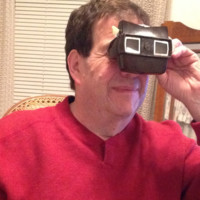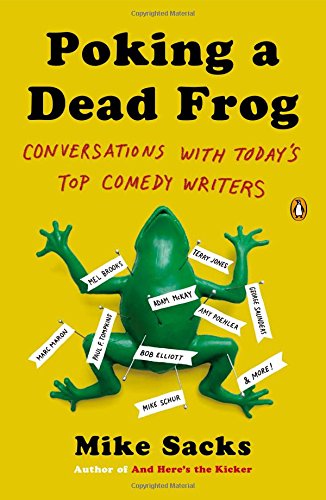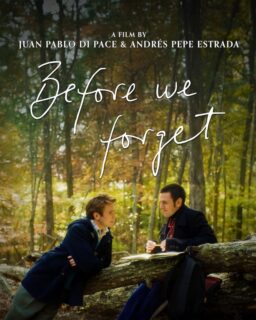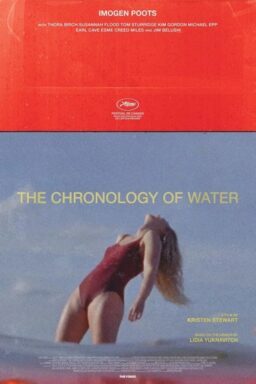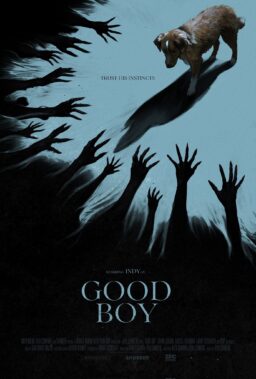”I am no humor expert,” Mike Sacks states in
the introduction to his new book, “Poking a Dead Frog: Conversations with
Today’s Top Comedy Writers.” But with this sequel to his 2009 book, “And Here’s
the Kicker” (recently re-released in what he calls an expanded “director’s cut”
edition with 200 extra pages), Sacks, a Vanity Fair staff writer, has
established himself as an insightful observer of the elusive comedic process.
“Dead Frog” (not to be confused
with Monty Python’s “Dead Parrot”) features interviews, “ultraspecific comedic
knowledge” and “pure hardcore advice” from a stellar array of legendary,
veteran and emerging comedic artists, including standups and performers (Patton
Oswalt and Amy Poehler), cartoonists (Daniel Clowes
and Roz Chast), and writers for radio (Bob Elliott of Bob and Ray legend), sitcoms
(Glen Charles, “Cheers”), late night talk shows (Todd Levin, “Conan”) print and
online (Henry Beard, “The National Lampoon” and Carol Kolb, “The Onion”) and
movies (Diablo Cody, “Juno”). And Mel Brooks!
The book (which you can buy here) takes its
title from E.B. White’s oft-quoted
observation in The New Yorker: “Humor can be dissected, as a frog can, but the
thing dies in the process and the innards are discouraging to any but the pure
scientific mind.” But Sacks’ deft poking unearths for comedy fans, nerds and
obsessives some precious treasures, such as Bill Hader’s list of 200 movies
essential for every comedy writer to see and Paul Feig’s intimately observed
show “bible” for the late, lamented, “Freaks and Geeks.”
Acknowledging
this site’s founder, Sacks began our conversation with an
appreciation of Roger.
MIKE
SACKS: He meant a lot to me. I thought he was an amazing writer and an amazing
person.
What was your exposure to him?
I grew
up in the D.C. area pre-Internet and pre-cable. There were a few great
reviewers for The Washington Post, but as far as movies I would have never
heard about otherwise, it was Roger Ebert. I just found him to be a great
writer, especially about the passage of time. His humanity, too, always came
through. He was my first link to a world (of movies) that I didn’t really know
about, movies that wouldn’t play on the big screens where I lived.
Going into “Poking a Dead Frog,”
how did you want to expand the conversation about writing comedy from the first
book?
With
‘And Here’s the Kicker,’ I wanted the interviews to be longer, but they were
cut back by the publisher With this new one I wanted to get into longer, Playboy-length interviews that would
have a nice arc—inspirations, experiences, advice. But the main purpose,
really, was to have another excuse to talk to my favorite comedy writers. I
wanted to focus on those who wouldn’t be here much longer, like Peg Lynch, 97,
as well as those who are emerging like Dan Guterman (‘The Colbert Report’).
“Kicker” was published in 2009.
How has the comedy landscape changed since then and how did that impact how you
approached this book?
That’s a
good point. When I pitched the first one, there were no books like this and
very few comedy sites. Marc Maron’s podcast (WTF) didn’t exist. The Onion’s A.V.
Club and a few other sites dealt with comedy. That was one of the problems with
the first book. It took a long time for
it to get published. It was rejected 25 times or so. Since then, things have exploded. There are
podcasts and websites. People seem to be making a career out of writing about
comedy. The New York Times has a comedy critic, Jason Zinoman.
Did the first book help you open
doors for the second?
I wish.
(laughs). No, in fact, it was more difficult. There is a lot more competition now. These top writers are being asked
much more frequently to be interviewed. With the first book, I would email
people like Larry Gelbart and others—the older ones who had AOL.com email
addresses—and they would get right back to me. With this one, it seemed like
there were more layers. I think it’s great, actually, that these people are
being asked to be on podcasts and to be interviewed for Splitsider, which is an
amazing website, or A.V. Club. But it wasn’t as easy as I thought it would be.
Analysis of why something is
funny can be deadly, but to your credit, the interviews are fascinating inside
looks at the process of creating comedy, which is much more illuminating.
Thanks,
but that goes for any occupation. Whether it’s a brain surgeon or an
electrician, every occupation has a process to it, a language and a lingo. “How
can one learn to be funny?” is an impossible question. What fascinates me is
(the writer’s) experience. How does one go from being a kid in Illinois, or
wherever, to becoming a professional writer of jokes? How does that happen? To
me, it’s a very mysterious process, but one that has always interested me.
I was fortunate to grow up in the
heyday of comedy albums, and watching comedians on “The Ed Sullivan Show” and
Johnny Carson’s “The Tonight Show.” What was your gateway into comedy?
It was Letterman and “Late Night,” and
especially Chris Elliott.
Mike Schur (“Parks and
Recreation”) remarks in your interview with him that reading Woody Allen was
like seeing in color for the first time. Was Letterman like that for you?
It was a
sensibility that was very approachable for a kid. The writing on that show was
so sharp and anti-everything we had not really enjoyed on TV variety shows.
Letterman cut through the BS. A lot of
the credit for that goes to (his former writer) Merrill Markoe. Her voice was
so strong. She really influenced an entire generation of comedy writers and
lovers.
Jerry Seinfeld has gotten flack
that his guests on “Comedians in Cars Getting Coffee” are not more diverse.
What was your process in seeking out your interview subjects?
It
wasn’t anything more than getting people whom I liked and, quite frankly, who
said yes. Beyond that, it was those who said yes and where the interview worked
out. A lot of interviews don’t. I interviewed 70 people and 45 made the final
cut. I think it helps, too, to be open
to everything, to have your feelers out to see what’s out there, whether it be
TV, movies, Twitter or graphic novels.
One of the biggest “gets” of this
book is Peg Lynch (creator of a Seinfeldian 1940s radio series, “Ethel and
Albert”). How did you find her?
That was
total luck. I would love to say that I knew about ‘Ethel and Albert’ where no
one else did, but what happened was I contacted an expert in radio humor and asked
if there were any radio comedy writers out there. He gave me a list of 15 who
were alive the last he checked five or 10 years ago. I went down the list, and
all of them were gone except for Peg Lynch who I tracked to a town in
Massachusetts. I called the town hall and they gave me her number. We proceeded
to talk for two hours at the first interview. It’s not like she was waiting for
someone to call necessarily, but I think she was perplexed as to why no one
hadn’t. She had not been interviewed in at least 50 to 60 years. She was one of
the few female comedy writers in the 1950s and ‘50s. She told me that over the
years, she has written more than 2,500 scripts. Her memory is incredible. And
the stories she told. It was like discovering gold. What was frustrating was
she kept saying, ‘This is nothing, you should hear the real story.’ I’d say,
‘Please tell me the real story.’
Your last book featured interviews
with Irving Brecher (who wrote for the Marx Brothers), George Carlin and Harold
Ramis, all of whom have since passed. While reading the new book, I couldn’t
help wish that you had been able to interview, say, Michael O’Donoghue
(co-founder of The National Lampoon”) before he died. What deceased comedy
writers do you wish you had gotten a chance to interview?
[O’Donoghue]
is one of them right there, and Doug Kenney (“Caddyshack”). Michael was real
slash and burn and Doug, it seemed to me, was a gentler spirit. And those two
working off each other [on “The National Lampoon”] was an amazing combination. I
would love to have talked with them.
What was your process like for
preparing for these interviews?
It was a
lot of work, up to 35 hours of research per interview. The problem was I didn’t
know how good (an interview) they would be, so I could do all that work and
then get on the phone and know instantly it was not going to work out. So that
was 25-35 hours down the drain.
One of the things I like most
about both books is learning about the writers’ influences and being introduced
to works that inspired them.
Usually
it starts with one figure and you go back and see what influenced them. I’m a huge Woody Allen fan and through him
you discover the Marx Brothers and S.J. Perelman. With Letterman it was Steve
Allen and Bob and Ray and all of those amazing people who influenced him. It
goes back and back and back. There is always someone to influence the next
generation.
A lot of
people turned me on to things I didn’t t know about. I hadn’t seen a good 80 or
so of the movies on Bill Hader’s list of the 200 movies every comedy writer
should see. It was just a good opportunity
to see what influenced someone who is that brilliant as a comedian and
performer. (The 1945 film noir) “Scarlet Street” is another good example. I had
never heard of it until Dan Clowes mentioned it. I learned a tremendous amount
form these people.
What is perhaps your biggest
takeaway from your interviews?
(Even at
their age) Mel Brooks and Peg Lynch are people who are never content with
resting on their laurels. They always want to achieve. That’s a tremendous
lesson for anyone. Mel Brooks gets up every morning and he goes to work. And as
writers that’s what you have to do. In the end, you just have to write. I would think someone like him would be satisfied
with what he’s accomplished but there’s an eagerness and hunger. He’s about to
go on Broadway to perform a one man show at 88 years old. What kind of
personality does that? It’s the same kind of personality that at 24 (drove him)
to get out of Brooklyn and achieve.
A recurring theme of these
interviews is that comedy is hard work
That’s
another valuable lesson. It doesn’t get easier. Someone who has written jokes
for 80 years still has questions whether a joke will work. Nothing (in comedy)
is guaranteed. If it’s hard for Mel Brooks, why shouldn’t it be hard for the
person who’s just starting out? There is no one answer in comedy. It’s not a
math equation. There’s always a sense of mystery.
You write very optimistically that
this is a golden age for comedy writing, but I wonder if this is more of a
golden age of opportunity?
I think
both, certainly compared to when I was in college and there were very few
outlets. With social media, someone writing jokes in their room in Maryland can
theoretically compete with, or have as many readers as New Yorker.com, That
didn’t exist before. The gates were being controlled by a certain type of executive
or whomever. One can circumvent that, which is pretty astonishing.
This is your second book of
interviews with comedy writers. Trilogy?
I don’t
know, I don’t think so.
Wait; In your interview with
(“Cabin Boy” director) Adam Resnick, he said he would wait for the third one to
talk to you about “The High Life” (his short-lived HBO series).
I think
it’s two and done, but I would like to write about ‘The High Life.’ (Adam) said
he was going to give me some bootleg VHS tapes. I’ve seen a few episodes, but I
would love to see them all.
One other thing: In your
interview with Henry Beard, he reflects on Ernie Kovacs and one of his
signature creations, the Nairobi Trio (gorilla masked musicians making like
wind-up toys to the tune of “Solfeggio”). He calls the bit “beyond bizarre” and
wonders, “Where did that idea come from?” In that spirit, I have to ask: You
include among your acknowledgements a reference to the 1979 teen rebellion
drama, “Over the Edge” (“To the upstanding citizens of the planned community of
New Granada—Tomorrow’s City… Today). Where did that idea come from?
God
bless you. That was in the first book and no one pointed it out. That’s one of
my favorite movies. It’s very underrated. That’s a case of a movie that’s not a
comedy, but it really influenced me. It just resonated. It was very ahead of its time in portraying
the reality of pre-fabricated communities and kids doing the best they could in
that environment. I loved the sign that opened that movie (referenced in the
acknowledgements). It was so yearning and so positive and what the reality became
was so awful.
And the photo that accompanies
the “About the Author” page. Isn’t that Jon Hamm?
He is
such a nice guy. He liked the first book. He posed for three or four hours on a
Saturday last year. For free. He just did it because he’s a fan of comedy.”
